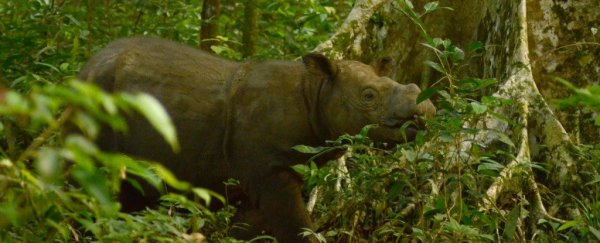With the death of Tam, the last male Sumatran rhino in Malaysia, another nail has been hammered into the species' coffin. Now, only one female Sumatran rhino named Iman remains in the country, ending efforts to produce offspring.
Tam fell ill in late April, losing his appetite and energy, and the decline was rapid. On Monday 27 May, the 30-something-year-old rhino breathed his last at the Tabin Wildlife Reserve in Sabah, which had been his home since he was captured in the wild in 2008.
"Today, we bid farewell to Tam, our last surviving male Sumatran rhino," WWF Malaysia wrote on Facebook. "Our hearts are filled with sadness as we mourn not only the loss of wildlife but the loss of a species."
His cause of death is not yet known, but early evidence suggests that his kidneys, and perhaps his liver as well, had begun to fail. It may have been simply due to age, as the life expectancy of Sumatran rhinos is 35 to 40 years.
The critically endangered Sumatran rhino (Dicerorhinus sumatrensis) was declared extinct in the wild in Malaysia in 2015, but while Tam remained alive, so too did a slender thread of hope.
Sadly, efforts to breed Tam using IVF with either of two captive females of his species - Puntung, captured in 2011, and Iman, captured in 2014 - produced no offspring.
Puntung was euthanised in 2017 after contracting incurable cancer. In Malaysia, Iman is now the last of her kind.
And it's not looking good for the rest of the world, either. Fewer than 80 individuals remain in the wild, scattered across parts of Kalimantan (the Indonesian part of the island of Borneo) and Sumatra, and numbers are still declining.
Habitat loss and ongoing poaching have driven the species to the brink of extinction.
It's not likely to get much better on its own. The remaining populations are small and isolated from each other; these rhinos are usually solitary animals unless mating or rearing their calves. This makes finding a viable mate even more difficult.
And then fertility is an added problem. Unless they regularly fall pregnant, female Sumatran rhinos develop uterine problems, such as cysts, that render them infertile. This, combined with Tam's poor-quality sperm, is why attempts to impregnate Iman and Puntung remained unsuccessful.
Iman is still producing viable eggs, which means IVF and surrogacy could be a possibility. However, Susie Ellis, executive director of the International Rhino Foundation, noted in a statement that attempts to trade gametes with Indonesian sanctuaries have also been unsuccessful in the past.
Tam's loss does underscore the urgency of finding the remaining Sumatran rhinos in the wilds of Kalimantan and Sumatra and bringing them to sanctuaries where they can be protected, along with a more concerted effort to produce calves.
The Malaysian sanctuary still holds out hope that Indonesia can be persuaded to join forces.
"We just have to look after the last remaining rhino," Augustine Tuuga, director of the Sabah Wildlife Department, told AP. "That's all we can do, and try if possible to work with Indonesia."
